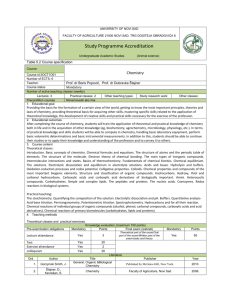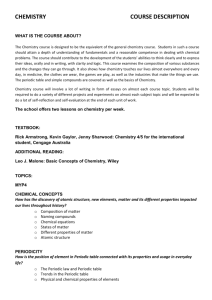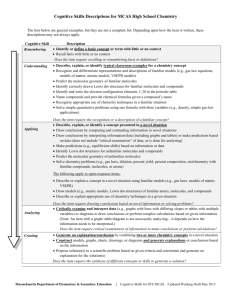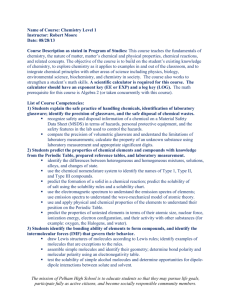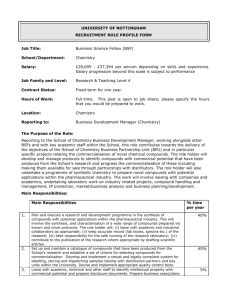CHEM1300-121912
advertisement
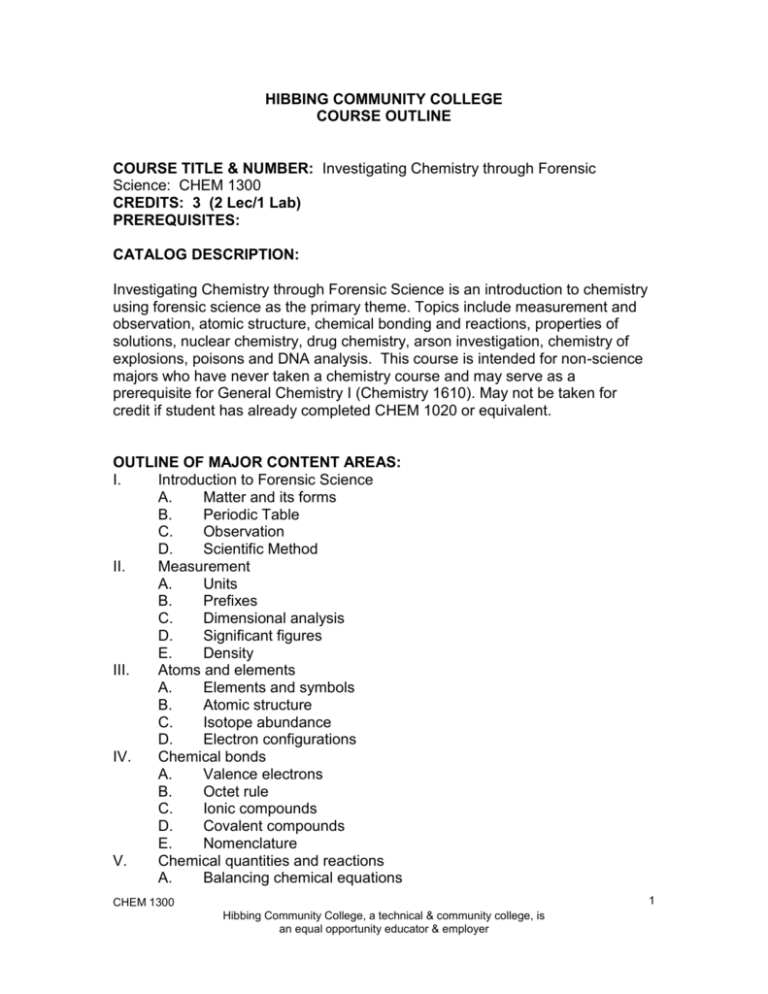
HIBBING COMMUNITY COLLEGE COURSE OUTLINE COURSE TITLE & NUMBER: Investigating Chemistry through Forensic Science: CHEM 1300 CREDITS: 3 (2 Lec/1 Lab) PREREQUISITES: CATALOG DESCRIPTION: Investigating Chemistry through Forensic Science is an introduction to chemistry using forensic science as the primary theme. Topics include measurement and observation, atomic structure, chemical bonding and reactions, properties of solutions, nuclear chemistry, drug chemistry, arson investigation, chemistry of explosions, poisons and DNA analysis. This course is intended for non-science majors who have never taken a chemistry course and may serve as a prerequisite for General Chemistry I (Chemistry 1610). May not be taken for credit if student has already completed CHEM 1020 or equivalent. OUTLINE OF MAJOR CONTENT AREAS: I. Introduction to Forensic Science A. Matter and its forms B. Periodic Table C. Observation D. Scientific Method II. Measurement A. Units B. Prefixes C. Dimensional analysis D. Significant figures E. Density III. Atoms and elements A. Elements and symbols B. Atomic structure C. Isotope abundance D. Electron configurations IV. Chemical bonds A. Valence electrons B. Octet rule C. Ionic compounds D. Covalent compounds E. Nomenclature V. Chemical quantities and reactions A. Balancing chemical equations 1 CHEM 1300 Hibbing Community College, a technical & community college, is an equal opportunity educator & employer VI. VII. VIII. IX. X. XI. XII. XIII. B. Stoichiometry C. Molecular structure Solutions A. Aqueous solutions B. Formation of ionic solutions C. Solubility D. Concentration units E. Acid-base chemistry F. IM forces G. Colligative properties Drug chemistry, an introduction to organic chemistry A. Organic compounds B. Structural isomers C. IUPAC nomenclature system D. Organic functional groups Arson investigation A. Combustion reactions B. Redox reactions C. Heat capacity and phase changes D. Calorimetry Chemistry of explosives A. Kinetic-molecular theory B. Gas laws Estimating time of death A. Chemical kinetics B. Collision theory C. Zero order reactions D. First order reactions E. Half life Nuclear chemistry A. Natural radioactivity B. Nuclear equations C. Radioactive isotopes D. Radiation detection and measurement E. Nuclear fission and fusion Poisons A. Chemical equilibrium B. LeChatelier’s principle C. Solubility equilibrium DNA analysis A. Biochemistry basics B. DNA basics C. DNA analysis 2 CHEM 1300 Hibbing Community College, a technical & community college, is an equal opportunity educator & employer COURSE GOALS/OBJECTIVES/OUTCOMES: Students will 1. describe the three states of matter and distinguish elements from compounds. 2. trace the development of the periodic table. 3. interpret and use atomic symbols, the periodic table and chemical formulas. 4. describe the scientific method. 5. distinguish chemical changes and properties from physical changes and properties. 6. distinguish mass from weight and explain the importance of units of measurement. 7. use conversion factors properly in solving mathematical problems. 8. identify significant figures in measurements and know how to determine them. 9. use the rules for determining the number of significant figures required in answers to calculations. 10. distinguish between accuracy and precision in experimental results. 11. use density as another physical property to investigate chemical evidence. 12. distinguish the two early schools of thought on the nature of the atom. 13. describe Dalton’s atomic theory. 14. list the main subatomic particles. 15. explain the concept of isotopes and describe how they can be used in scientific research. 16. determine the atomic mass of an element with isotopes. 17. describe the modern model of the atom and contrast it to earlier models. 18. describe the various regions of the periodic table. 19. write the names and formulas of covalent and ionic compounds. 20. balance chemical equations. 21. determine the molar mass of compounds and do basic gram-mole conversions. 22. use balanced chemical equations to determine the relationship between quantities of reactants and products. 23. identify and classify basic chemical reactions. 24. explain the valence bond theory of covalent bonding. 25. draw the Lewis structures of covalent compounds. 26. predict the three-dimensional shape of a molecule. 27. determine the polarity and solubility of compounds. 28. distinguish between electrolytic and non electrolytic solutions. 29. determine when a solution is unsaturated, saturated or supersaturated. 30. determine the concentration of a solution. 31. explain the Arrhenius definition of acids and bases. 32. distinguish between strong and weak acids and bases. 33. explain the products of a neutralization reaction and what chemists mean by “salt”. 3 CHEM 1300 Hibbing Community College, a technical & community college, is an equal opportunity educator & employer 34. describe what the pH scale measures and what a buffer does. 35. calculate the pH of solutions. 36. identify the different intermolecular forces and how they affect the physical properties of a substance. 37. explain how water dissolves certain compounds. 38. explain on a molecular level why solutions have higher boiling points than the pure solvent. 39. illustrate how the freezing point of a solution will change because of the concentration of the solute. 40. describe the process of osmosis and its effect on pressure and concentration. 41. differentiate between organic and inorganic compounds. 42. name alkenes and alkynes and draw their structures. 43. identify and name isomers. 44. name and describe cyclic compounds.. 45. recognize compounds containing the major organic functional groups. 46. explain the concept of thermal equilibrium and the chemistry of fire. 47. assign oxidation numbers and identify oxidation and reduction processes. 48. describe endothermic and exothermic processes. 49. describe what happens when heat is added to a substance. 50. calculate the heat needed for phase changes and temperature changes. 51. perform calculations in calorimetry. 52. differentiate between low and high explosives. 53. determine an explosive molecules oxygen balance. 54. explain the properties of gases using the kinetic-molecular theory. 55. use the gas laws to describe how gases behave. 56. explain how Dalton’s law of partial pressures relates to mixtures of gases. 57. explain why kinetics is important in understanding reactions. 58. explain what happens on a molecular scale during a reaction. 59. relate temperature to the rate of reaction. 60. describe how a catalyst increases the rate of reaction. 61. explain the concept of half-life. 62. trace Becquerel’s experiments that led to the discovery of radioactivity. 63. explain the risks in handling radioactive materials. 64. write balanced equations for the radioactive decay of an isotope. 65. explain how the properties of radioisotopes are used for medical diagnosis and treatment of disease. 66. explain how the half-life of carbon-14 can be used in forensic investigations. 67. describe how nuclear power plants generate electricity. 68. describe the military uses of uranium and plutonium. 69. describe the characteristic properties of a poison. 70. describe chemical equilibrium and how it relates to poisons. 71. explain how dynamic equilibrium is established and the effect of adding a catalyst. 72. identify fats, oils and waxes by their molecular structure. 4 CHEM 1300 Hibbing Community College, a technical & community college, is an equal opportunity educator & employer 73. describe the structure of carbohydrates. 74. describe the role of amino acids in the structure of proteins. 75. describe the way the information in a DNA molecule is coded. 76. describe the techniques used to take a sample of DNA and analyze its genetic information. 77. perform laboratory experiments relevant to the lecture material studied. 78. collect and interpret data, both statistically and graphically. 79. present written findings of their experiments. 80. gain a deeper understanding of the role of science in everyday life and the implications of a scientifically illiterate public. MNTC GOALS AND COMPETENCIES MET: Natural Sciences HCC COMPETENCIES: Thinking Creatively & Critically STUDENT ASSESSMENT SHALL TAKE PLACE USING INSTRUMENTS SELECTED/DEVELOPED BY THE COURSE INSTRUCTOR. SPECIAL INFORMATION: (SPECIAL FEES, DIRECTIVES ON HAZARDOUS MATERIALS): Hazardous chemicals will routinely be used in laboratory. Students will be supplied with pertinent information relating to the safe handling of these materials at the appropriate time. AASC APPROVAL DATE: December 19, 2012 REVIEW DATE: December 2017 CHEM1300: so 121912 5 CHEM 1300 Hibbing Community College, a technical & community college, is an equal opportunity educator & employer


